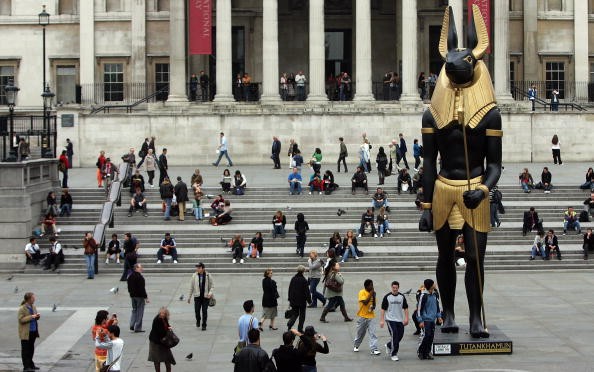‘God of Death’ Keeps Canine Mummies, New Study Finds
| KJ Belonio | | Jun 20, 2015 01:51 AM EDT |
(Photo : Getty Images/Gareth Cattermole) A new study published in the June issue of the journal Antiquity revealed that archaeologists recently discovered that Egypt’s “God of Death,” Anubis, had kept almost 8 million canine mummies.
A new study recently discovered that Egypt's "God of Death," Anubis, had kept almost 8 million canine mummies. The mummified puppies and grown dogs were found in the catacombs next to his sacred temple.
Like Us on Facebook
Through the discovery of the canine mummies, archaeologists said they have found enough proof that the Anubis animal cult played a huge role in the ancient Egyptian economy, Yahoo! News U.K. noted.
Aside from the canine mummies, the catacomb ceiling also contains an ancient sea monster fossil, a marine vertebrae that is over 48 million years old and was likely a relative of the modern-day dugongs and manatees. However, researchers said that it is unclear whether the Egyptians noticed the existence of the fossil when they built the tomb for the mummified dogs.
Archaeologists also found catacombs with mummified remains of other animals such as the long-legged birds known as the ibis, hawk, baboon and bull. According to Discovery News, these mummified animals suggested that ancient Egyptians also worshipped other animal gods.
In addition, researchers excavated mummies of jackals, foxes, falcons, cats and mongoose. However, about 92 percent of the remains belong to dogs. And the reasons are still vague why these other animals were buried in the canine catacomb.
As stated in the study published in the June issue of the journal Antiquity, researchers found that there's a possibility that all "doglike" creatures found were interchangeable and its mythological reasons probably inspired the choice of cats and raptors.
U.K.'s Cardiff University archaeology professor and lead study author Paul Nicholson said that during the Late Period (747 to 332 B.C.), Saqqara would have been a busy place. It was a permanent community of people living there supported by the animal cults, which mummified their animals in honor of the gods.
Nicholson added many of the dogs were only hours or days old when they were mummified. Some older dogs had more elaborate burials, and may have lived at the temple. But the younger pups were likely bred for the cult. Nicholson also said that the pups weren't killed by physical action, instead they likely died from dehydration or starvation.
For over a thousand years, Egypt has been known to be a nation that has a penchant for mummifying animals. And while some archaeologists spent a little time detailing the canine catacombs, the new study has analyzed its depth. Live Science revealed that Nicholson and his team spent countless of hours in examining the larger catacomb by studying its rock walls and mummified contents.
"It's a very long series of dark tunnels," Nicholson said. "There is no natural light once you've gone into the forepart of the catacomb, and beyond that everything has to be lit with flashlights. It's really quite a spectacular thing."
The researchers also explored every possible nook of the catacombs that were likely built in the fourth century B.C. and were made out of stone from the Lower Eocene, which is about 56 million to 48 million years ago.
Animal cults, which may have been a symbol of national identity, remained popular in Egypt during the ancient times, but they declined during the Roman occupation. Meanwhile, ancient Egyptians built the temples and catacombs in Saqqara, a burial ground in the country's ancient capital of Memphis, in honor of the Egyptian "God of Death," Anubis.
TagsGod of Death, Anubis, Mummy, Catacomb, Egypt
©2015 Chinatopix All rights reserved. Do not reproduce without permission
EDITOR'S PICKS
-

Did the Trump administration just announce plans for a trade war with ‘hostile’ China and Russia?
-

US Senate passes Taiwan travel bill slammed by China
-

As Yan Sihong’s family grieves, here are other Chinese students who went missing abroad. Some have never been found
-

Beijing blasts Western critics who ‘smear China’ with the term sharp power
-

China Envoy Seeks to Defuse Tensions With U.S. as a Trade War Brews
-

Singapore's Deputy PM Provides Bitcoin Vote of Confidence Amid China's Blanket Bans
-

China warns investors over risks in overseas virtual currency trading
-

Chinese government most trustworthy: survey
-

Kashima Antlers On Course For Back-To-Back Titles
MOST POPULAR
LATEST NEWS
Zhou Yongkang: China's Former Security Chief Sentenced to Life in Prison

China's former Chief of the Ministry of Public Security, Zhou Yongkang, has been given a life sentence after he was found guilty of abusing his office, bribery and deliberately ... Full Article
TRENDING STORY

China Pork Prices Expected to Stabilize As The Supplies Recover

Elephone P9000 Smartphone is now on Sale on Amazon India

There's a Big Chance Cliffhangers Won't Still Be Resolved When Grey's Anatomy Season 13 Returns

Supreme Court Ruled on Samsung vs Apple Dispute for Patent Infringement

Microsoft Surface Pro 5 Rumors and Release Date: What is the Latest?










